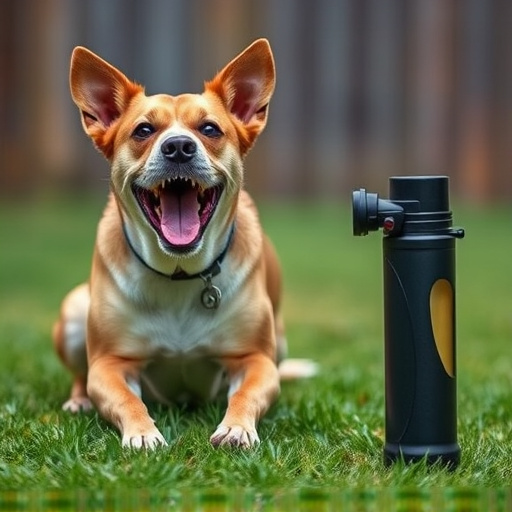Dog repellent sprays effectively deter canines using ingredients like capsaicin and citronella, but safe usage is paramount. Maintain a 10-20 foot (3-6 meter) safe spraying distance, follow instructions carefully, and conduct preliminary tests to avoid potential irritation or harm. This ensures optimal reach and minimizes risk to both humans and dogs, while also adhering to legal and environmental considerations for responsible use.
Looking to protect your space from unwanted canine visitors? Dog repellent spray offers a powerful solution. This comprehensive guide explores maximum strength dog repellents, delving into active ingredients, safety concerns, and effective application techniques. We’ll also dissect legal considerations and environmental impact, including the crucial aspect of understanding the safe spraying distance for dogs. By the end, you’ll be armed with the knowledge to make an informed choice for your needs.
- Understanding Dog Repellent Spray: Active Ingredients and Safety
- Safe Spraying Distance for Dogs: How Close is Too Close?
- Effective Application Techniques for Maximum Protection
- Legal Considerations and Environmental Impact of Dog Repellents
Understanding Dog Repellent Spray: Active Ingredients and Safety
Dog repellent sprays are designed to discourage dogs from entering or lingering in a specific area, but understanding their composition and safe use is essential. These sprays typically contain active ingredients like capsaicin (derived from chili peppers), citronella, or other natural oils known for their strong odors that can repel canines. While these ingredients are generally considered safe when used correctly, it’s crucial to follow instructions carefully to avoid potential risks.
When applying a dog repellent spray, maintaining a safe spraying distance is vital. Most products recommend keeping a distance of at least 10-15 feet (3-4 meters) from dogs, as direct contact or inhalation of the spray can cause irritation. Always test the spray in a controlled setting first and ensure it doesn’t pose a harm to people or pets, especially if you have sensitive individuals nearby.
Safe Spraying Distance for Dogs: How Close is Too Close?
When considering a dog repellent spray, understanding the safe spraying distance for dogs is paramount to ensuring both effectiveness and your pet’s well-being. It’s crucial to adhere to the recommended applicator instructions that come with the product, which often suggest keeping a safe distance from targeted areas. This is because direct or overly close proximity to the spray can potentially irritate a dog’s sensitive eyes, nose, and respiratory system. In many cases, a safe spraying distance typically ranges from 10 to 20 feet (3 to 6 meters), allowing for effective deterrence without causing discomfort.
To maximize safety during application, users should aim the nozzle away from direct contact with dogs and spray in a downward motion, focusing on the desired area rather than directly at them. This technique not only ensures minimal risk of injury but also optimizes the repellent’s reach and potency, making it an effective tool for managing unwanted canine interactions while maintaining a safe environment for both humans and their furry friends.
Effective Application Techniques for Maximum Protection
When using a dog repellent spray, understanding the safe spraying distance is crucial for maximum effectiveness and user safety. It’s recommended to maintain a distance of at least 10 feet (3 meters) from your target area when applying the product. This ensures that you avoid direct contact with the spray while allowing it to reach and coat the desired surfaces. Holding the canister too close may result in inhalation issues or skin irritation, especially for sensitive areas like eyes and nostrils.
For optimal results, evenly and liberally apply the spray across all visible areas where dogs are likely to enter or rest. Focus on points of entry such as doors, windows, and fences, as well as common resting spots like patios, balconies, and gardens. Using a safe spraying distance and proper application techniques will not only deter dogs but also ensure that the repellent remains effective for an extended period without requiring frequent reapplication.
Legal Considerations and Environmental Impact of Dog Repellents
When considering dog repellents, it’s crucial to navigate legal and environmental factors, especially when opting for maximum strength sprays. Each region has its own set of regulations regarding the use of chemicals that may repel dogs, including restrictions on active ingredients and permitted application methods. For instance, some areas strictly regulate or even prohibit certain aerosol sprays due to health and environmental concerns.
The safe spraying distance for dogs is a critical consideration. To minimise potential harm, follow manufacturer guidelines and local regulations for application. Additionally, be mindful of the environment; these repellents can impact non-target species, such as birds and beneficial insects. Opting for pet-safe formulas and using them responsibly can help mitigate ecological effects, ensuring that dog repellent use is both effective and environmentally friendly.
Dog repellent spray can be an effective tool to manage interactions between dogs, but understanding safe spraying distances and responsible application is key. By adhering to recommended guidelines on active ingredients, safety, and environmental impact, you can ensure maximum protection without causing harm. Remember, the “safe spraying distance for dogs” varies based on factors like wind and scent dispersion, so always follow manufacturer instructions. Responsible use of dog repellent spray, combined with other methods like training and fencing, can contribute to a more peaceful and harmonious environment for both pets and their owners.
